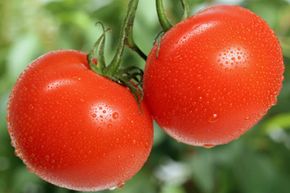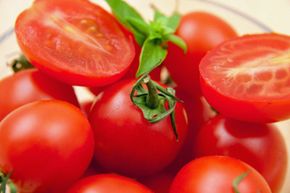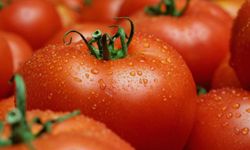Preparing homemade spaghetti sauce from your own homegrown tomatoes is one of the unexpected delights of being a backyard gardener. Tomatoes are rich in vitamins, minerals and antioxidants like lycopene. What could be more wholesome than a big plate of spaghetti topped with sauce from tomatoes you picked a few hours ago? Even prepared tomato sauces taste more vibrant when you add a little fresh tomato to them. Growing vegetables in your garden can be a great bargain, too. It's a time-honored way to stretch your food dollar, and tomatoes are an easy crop to grow, harvest and use in recipes.
Preparing Tomatoes for Sauce
Five pounds of tomatoes will yield approximately 12 cups of sauce. Roma tomatoes (also called paste or plum tomatoes) work best, but any tomato variety will do. To prepare tomatoes, peel, core and seed them. When they're cool enough to handle, squeeze them in a couple of lengths of cheesecloth to remove the excess liquid. Process the remaining pulp through a food processor or blender until smooth. Refrigerate the puree for a couple of hours, and then drain off any excess clear liquid. At this point, you have a good foundation for spaghetti sauce and many other tomato-rich dishes like barbecue sauce or ketchup.
You may remember your grandmother cooking her red sauce for long hours on the back stove burner. That was mostly to thicken it by evaporating the excess water. If you squeeze out much of the excess moisture before you cook your tomato mixture, you'll be able to keep cooking time to a couple of hours at a light simmer. This is long enough to create rich flavor but still retain some fresh garden goodness. To avoid a metallic tasting sauce, use a non-reactive pan like enamel or tempered glass to cook all of your tomato-based dishes.
Putting Spaghetti Flavor in Fresh Tomato Sauce
It's the seasonings that give tomato-based spaghetti sauces their distinctive flavor and aroma. You'll find lots of pre-blended spaghetti seasoning mixes on the market, but most use conventional Italian spices like oregano, garlic and basil. Many also add onion and bay leaf. If you love the taste of sweet spaghetti sauce, look for seasonings that include ingredients like brown sugar or molasses. If you discover that your homemade sauce has more of a sharp, acidic taste than you'd like, add a tablespoon of cream Sherry for every quart of sauce (or to taste). It will help tame the bite.
For a perfect blend of flavors, try adding some of these popular ingredients to homemade spaghetti sauce too:
- garlic (fresh minced, paste or powdered)
- caramelized onion
- sautéed bell pepper
- carrot (shredded)
- mushrooms
- oregano
- basil
- thyme
- olive oil
- burgundy
- bay leaf
- Parmigiano-Reggiano
- paprika
- fennel seed
- anchovy paste
Putting It All Together
Since there are so many spaghetti sauce recipes around, it's easy to see that savvy cooks are experts at refining tomato dishes to suit their family's tastes. When you're combining ingredients for your own homemade spaghetti, add onions, oil, wine, bay leaf and garlic when you put the sauce on to simmer. Wait until the last half hour of cooking to add most of the spices and other ingredients. This will keep the spices vibrant while giving the initial ingredients time to release their flavors.
For the best results, add precooked meat during the first 20 minutes of cooking time. A couple of good choices are meatballs made from ground brisket and breadcrumbs, and savory Italian sausage cut into one-inch pieces. Even though meat is always a welcome addition, homemade spaghetti sauce is tasty and filling even without it.
Whether you plan on using your entire crop of tomatoes or only a few, these hearty pasta dishes are delicious, easy to prepare and will help you create some welcoming aromas and flavors in your kitchen during those long fall evenings:
- Baked Ziti Casserole
- Italian Meatballs and Peppers
- Penne with Tomatoes and Pine Nuts




